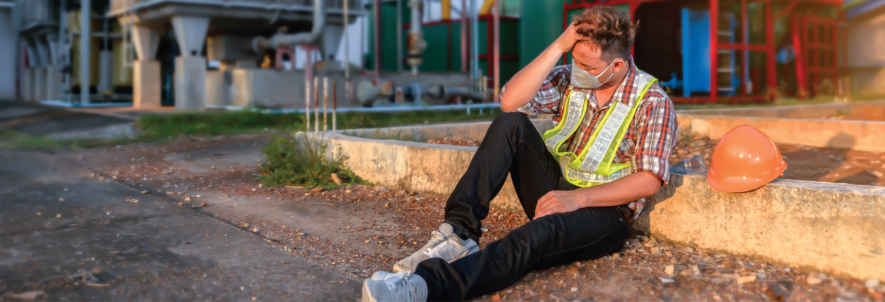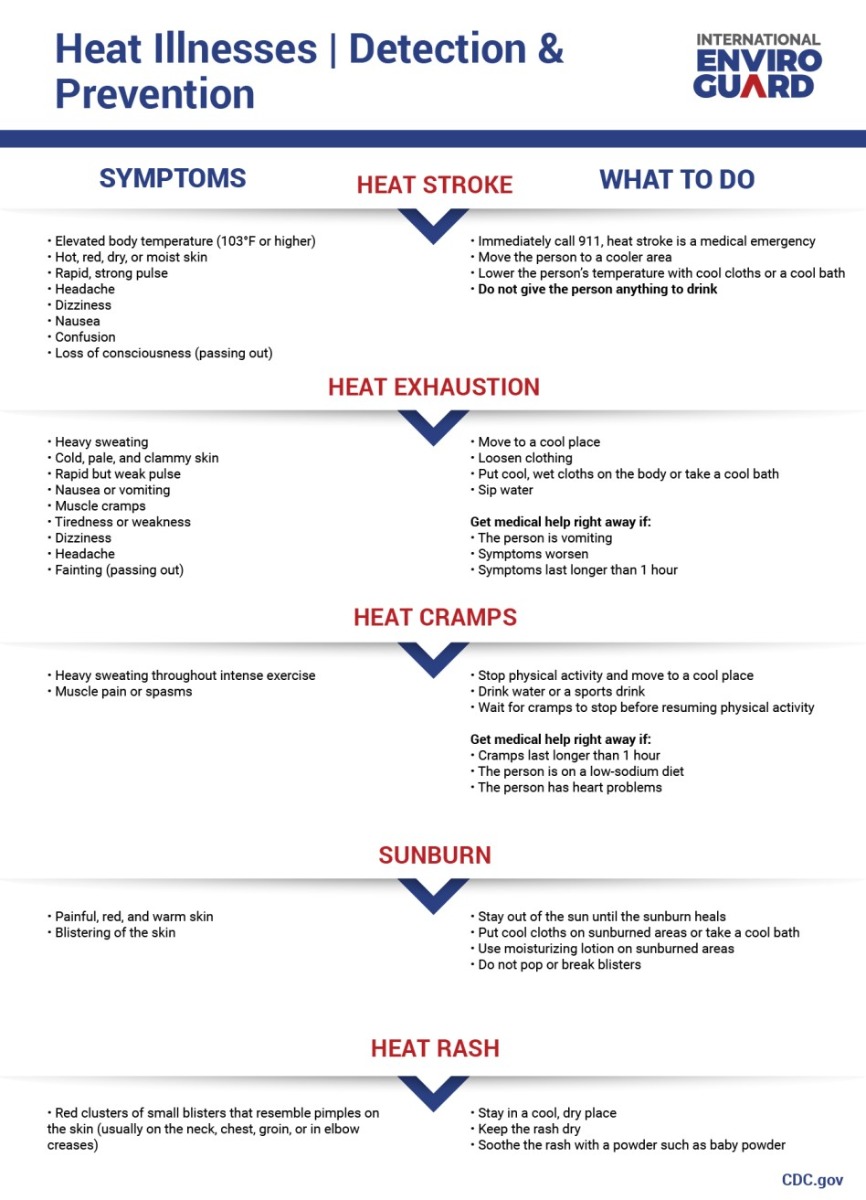
When working outside, it's crucial to protect workers as much as possible from the elements. Even when conditions are pleasant, too much sun exposure can become a serious problem, leading to heat stress and exhaustion.
According to the CDC, from 1992 to 2016, 285 construction workers died from heat-related illnesses while on the job. This number accounts for more than a third of all heat-related occupational deaths in the United States. Outside of construction, around 700 people die every year from heat exposure, either directly or indirectly.
These figures illustrate the need for employers to have high-quality health and safety standards in place for all workers. These standards can include personal protective equipment (PPE), work safety guidelines, and best practices for preventing heat stress. In this article, we'll dive into the effects of heat exhaustion and heatstroke and how you can keep your workplace safe.
What is Heat Exhaustion/Heat Stress?
The human body needs sufficient water and minerals to function correctly. Severe dehydration can lead to various problems, including stomach cramps, nausea, headaches, dizziness, and even fainting. These symptoms are collectively known as heat exhaustion when they are caused by prolonged exposure.
There are two types of heat exhaustion - water depletion and salt depletion. Both of these options can be serious, and if left unchecked, can lead to heatstroke or other significant health issues.
What are the Signs and Symptoms of Heat Exhaustion?
The most common signs of heat exhaustion include:
- Excessive Sweating
- Confusion
- Dizziness
- Fatigue
- Fainting
- Headaches
- Pale Skin
What is Heat Stroke?
Heatstroke is a much more serious heat-related illness that can cause permanent bodily damage or even death if left untreated. This condition happens when the body is unable to regulate its core temperature any longer. As you know, the average internal temperature should be around 98.6 degrees Fahrenheit. When heatstroke sets in, body temperature can climb to 105 or 107 degrees Fahrenheit in just a matter of minutes.
What are the Signs and Symptoms of Heatstroke?
- Excessively red and hot skin
- Dry skin with no sweat
- High internal temperature (103 degrees or more)
- Dizziness
- Extreme confusion
- Fainting
- Rapid pulse
If you notice anyone with these symptoms, they must be treated as soon as possible. Otherwise, the condition will worsen and could potentially lead to permanent brain damage or death.
Which Industries Are Most Exposed to Heat Exhaustion and Heatstroke?
Although direct sun exposure can lead to heat stress, these conditions can occur in other industries where employees work in hot and humid conditions. Some examples of sectors where heat-related illnesses are most common include:
- Agriculture and Farming
- Construction Work
- Landscaping
- Postal Service and Package Delivery
- Oil and Gas Job Sites
- Bakeries and Kitchens
- Industrial Laundry Services
- Electrical Utilities
- Metal Foundries
- Fire Services (i.e., firefighting)
- Manufacturing
- Warehousing
In addition to being in a hot environment, intense physical labor can lead to heat exhaustion and stroke. When employees move around a lot and do heavy lifting, their bodies will naturally warm up. Combined with higher ambient temperatures, it's much harder for individuals to stay cool.
Humidity can also be a significant factor since sweat cannot evaporate from the skin. So, hot and steamy environments can be an even greater risk to workers, particularly if they don't have the proper protective equipment.
How to Treat Heat Stress or Heat Stroke
Before trying to help someone suffering from a heat-related illness, it's vital to note that there are different procedures for heat exhaustion and heatstroke. Here are the recommended treatment guidelines for each situation.

For Heat Exhaustion
First, move the person to a cool, shaded area. If they are indoors, take them to a cooler part of the building, such as an office or break room. Soak clothing or towels with cool water and place them on the person's forehead and neck. If the person is wearing multiple layers of clothing, they should remove the outer layers to cool down.
While the individual may want to guzzle water, too much hydration can be harmful. Instead, they need to sip water regularly until they start feeling better. Be sure to monitor their condition and take their temperature to ensure that it is not too high. If the symptoms worsen or continue for more than an hour, you need to call an ambulance.
For Heatstroke
Since this is such a serious medical emergency, you should call 911 as soon as possible. With heatstroke, the goal is to cool the person down. While it may make sense to help them hydrate, it's actually a bad idea to give the person any water or fluids. The reason to avoid drinking water with heatstroke is that the water will warm up inside the person and make it harder for them to cool down. Instead, use an ice bath or cold towels to lower their internal temperature until the paramedics arrive.
Other Common Heat-Related Illnesses
Although heat exhaustion and heatstroke are relatively common, they are not the only heat-related illnesses that workers can experience on the job. Here are some other potential health issues to pay attention to and prevent.
- Sunburn -Exposure to direct sunlight can damage the skin and cause burns. Mild sunburns are easily treated, but they can worsen with prolonged exposure. Severe sunburns can lead to blistering and permanent skin damage. In some cases, individuals may feel nauseous or weak. Sunburns can also be quite painful for days afterward, affecting an employee's ability to perform various tasks.
- Heat Rash -While similar to a sunburn, heat rashes are caused by excessive sweating and rubbing. As the sweat dries, it leaves salt behind, which can aggravate the skin. Heat rash is a relatively minor illness but requires treatment and prevention to ensure that it doesn't worsen. Individuals should use powder to keep the skin dry, however, moisturizers and creams can actually make the condition worse.
- Heat Cramps - Salt depletion and dehydration cause muscles to seize, creating painful cramps. Typically, heat cramps are a result of strenuous activity in a hot environment. Workers may complain of serious aches and pains, and they may even experience muscle spasms. Hydration is the best response to heat cramps, but it can take a while for the pain and soreness to subside.
- Heat Syncope - Advanced protective equipment must always be worn in workplaces that leverage harsh and flammable chemicals. These contaminants not only pose a severe burn hazard but can also quickly damage the lungs.
How Can Companies Prevent Heat Exhaustion and Stroke?
- Breaks -Prolonged heat exposure can lead to many problems, so the easiest way to prevent them is to offer consistent breaks. Those working in direct sunlight or next to hot equipment should get breaks more frequently to avoid potential illnesses. Make sure that break areas are cool and shaded so that it's quicker and easier for employees to lower their internal temperature.
- Hydration -Dehydration is a significant contributing factor to most heat-related illnesses. Workers should have access to water at all times, either by carrying bottles or visiting nearby water stations. Water intake should not be limited to breaks, either. Workers should drink regularly while on the job, particularly in hotter areas where sweating is more likely.
- Buddy System -If someone does come down with heat exhaustion or stroke, it's imperative to take action immediately. If workers are left alone, they could wind up in a dangerous or deadly situation. Implementing a buddy system can prevent serious complications. Employees should stay close to each other or check in via radio at regular intervals. Make sure that buddies ask about each other's physical condition and provide breaks as necessary. They should also be able to recognize the symptoms of heat-related illnesses to decrease risk and prevent more serious health effects.
- Personal Protective Equipment -Having the right PPE for your employees can protect them from the sun and potential heat-related illnesses. We'll discuss specific PPE in the next section, but examples can include hats and personal cooling systems.
Which PPE Works Best for Combating Heat Exhaustion and Stroke?
Many types of PPE can actually increase the odds of heat exhaustion or stroke by trapping heat next to the body and raising a person's internal temperature. To combat this problem, employers should offer lightweight, breathable PPE that enables the wearer to stay cool while working. The best PPE should have the following characteristics:
- Bright -Lighter colors reflect more sunlight, meaning that the clothing or equipment doesn't retain as much heat.
- Lightweight -Heavier PPE can be more burdensome as it forces the wearer to work harder to move.
- Breathable -Thick materials don't allow sweat to evaporate, leading to heat rash and a higher core temperature.
- High Moisture-Vapor Transmission Rate -Look for PPE with a high MVTR.
What is MVTR, and How Does It Relieve Heat Stress?
Moisture-vapor transmission rate determines how well water can pass through a substance. When talking about PPE, MVTR refers to how well sweat can evaporate through the material. Clothing and other equipment with a high MVTR rating ensure workers can stay cool while on the job. Since more sweat can pass through, individuals can regulate their core temperature more efficiently.
Buy High-Quality PPE From International Enviroguard
Heat illness prevention is easy when you have the right equipment. We offer the best PPE for hot environments that will keep your employees safe and well-protected.
The following product lines below are made of lightweight, breathable fabrics that help keep workers cool over long hours. To learn more about which PPE fabric types and International Enviroguard garments provide a high MVTR, read along here.